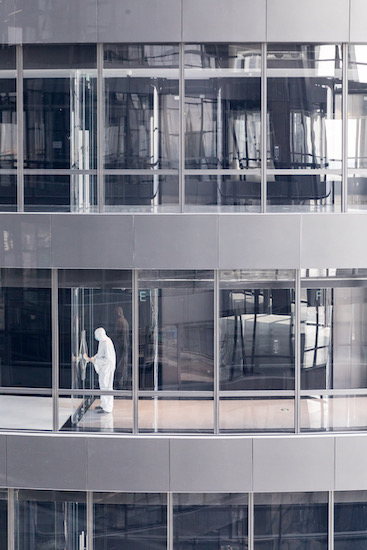To control the community spread of coronavirus, Americans are increasingly working at home, isolating themselves. But China, the source of the pandemic, now is doing the opposite. The government is allowing people to return to work while taking serious measures to reduce the spread of the disease. Officials have added social control to the social distancing already practiced by the Chinese and are leveraging buildings to implement the control.
Since early February, approximately two weeks after Chinese New Year, office buildings in major cities have effectively become filtering machines to monitor and control the outbreak. Under government orders from Beijing, anyone going to work is checked at the entrances to office buildings for fever, and is logged in so that movements—and therefore the pattern of human contact in a day of work—can be tracked. Door inspections are part of a larger national program that includes fever checks even when people step onto a bus or enter their own apartment building.

“Every office building on every street in every district needs to report how many people enter, and who goes in and out,” says Xin Zhang, CEO of SOHO China, the largest developer in China. Since 1995, her company has developed over 54 million square feet of commercial space in Beijing and Shanghai (architects have included Zaha Hadid, Kengo Kuma and Kohn Pedersen Fox). “Everybody now is back to work—everybody wearing masks—and monitoring is very strict, with the numbers reported to the government daily.”
Besides checking workers at every entrance, the government wants building owners to sanitize the buildings beyond the normal cleaning. SOHO properties are swabbed like ships. According to Ms. Zhang, in a program of deep and continuous cleaning, every surface within reach in SOHO buildings, including floors, is sanitized with disinfectants, wiped on by hand, mopped, or sprayed, every half hour. That includes SOHO’s new Leeza skyscraper, the twisting glass tower by Zaha Hadid Architects featured on RECORD’s January cover. “Going into the crisis, managers of most buildings already had basic sanitary kits, and Asians are used to wearing masks because of pollution, so they are compliant,” she says. “But this a very different level of prevention.” With control at the building level, combined with many other preventative measures organized by the government, the country reported on Thursday, March 19, that it had no new local infections—a first, since the outbreak began.










Post a comment to this article
Report Abusive Comment